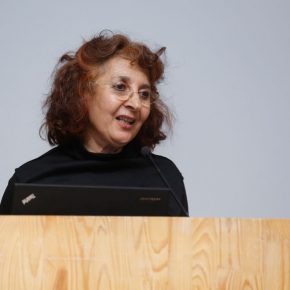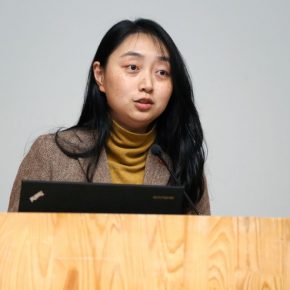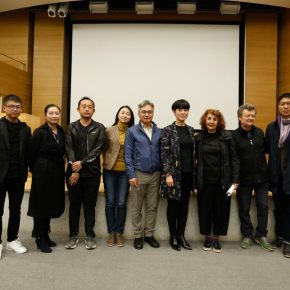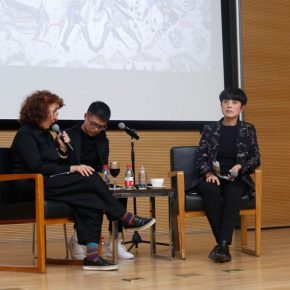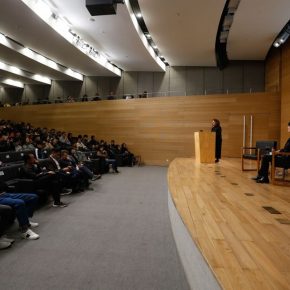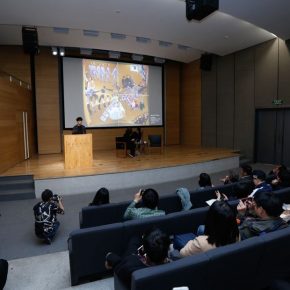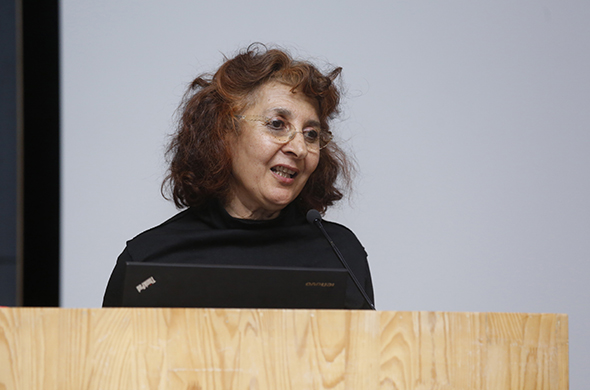
On the evening of 24 October 2018, Shirazeh?Houshiary who was born in Iran and now lives in the United Kingdom, together with Yu Hong, a professor from the Department of Oil Painting at the Central Academy of Fine Arts launched a lecture entitled “The Enlightenment of Contemporary Art in Dunhuang” in the Auditorium of the CAFA Art Museum. It was jointly hosted by?CAFA Art Museum?and?Zhonghongchuangyi (Beijing) Culture Development Co., Ltd. The two artists enjoyed a discussion on the murals and statues of Mogao Grottoes in Dunhuang, taking their experiences of study and growth as the context?to share their thoughts of creation, leading the audience to face a reflection of history and?to think of the blending of cultures as well as enjoying?contemporary art.
Shirazeh?Houshiary was born in Iran?in?1955. She moved to London in 1974 and studied at the Chelsea School of Art, London, and now she lives and works in London. Her artistic practices span the fields of painting, installation, architecture and film, the use of art as the medium to focus on the topics of cosmic physics, religion, philosophy and poetry. She was short-listed for the Turner Prize at the Tate Gallery in 1994, and was awarded the 2018 Asia Game Changer Award in March 2018.
Yu Hong was born in Xi'an, China in 1966. She studied oil painting at the Central Academy of Fine Arts in the 1980s. Yu graduated from the Department of Oil Painting at?the Central Academy of Fine Arts in 1996, with a master’s degree. Since 1988, Yu has taught at the Department of Oil Painting at the Central Academy of Fine Arts. Her works mainly reflect current lifestyles and she is keen to observe the people around her. She is good at using artistic language to question the current situation, and is also tracing the past in order to find an answer. Seen from the works by?Yu Hong, the spectators can also see the explanations?of her exploration of media and materials, religion, philosophy and culture.
The discussion was divided into three parts, first of all, Shirazeh?Houshiary and Yu Hong independently delivered a speech; secondly, Shirazeh?Houshiary talked?with Yu Hong; in the end, the artists answered the questions raised by the audience. Although the two artists have completely different backgrounds in growth and learning, using different media and artistic language to express the individual will and create different understandings of the knowledge of?Mogao Grottoes, they are all filled with veneration for the art of Mogao Grottoes on the Silk Road. They all?recalled their memories of Mogao Grottoes and?exchanged their views on traditional culture?used?in their creative practice.
Shirazeh?Houshiary has recently finished an investigation of Dunhuang, and she has never covered the excitement brought by the trip to Dunhuang when she was delivering a speech. First of all, she described the process of developing a liking for Dunhuang. Shirazeh?Houshiary was interested in the stories of the Silk Road when she was a child, and then she met a friend who was going on a trip to Dunhuang when she moved to?London. It seemed that it was an opportunity waiting for the artist to take and she had a deep longing for Dunhuang while a Chinese collector told her about the magnificence of Dunhuang art and later she saw images of the Mogao Grottoes. She was?greatly impressed by the strength brought by the colors of mural paintings, as well as Dunhuang’s unique regional characteristics. She thought that the desert was a land of purity, while it also brought people with a sense of emptiness. She said?“Silk Road” offered cultural communication a channel and brought life to this?region.
Shirazeh?Houshiary then talked about Cave 285 and Cave 220, Mogao Grottoes in her speech. Cave 285 built in the Western Wei Dynasty in the sixth century A.D. was the earliest cave of the Mogao Grottoes and it was rebuilt in the dynasties of Tang, Song, Western Xia and Yuan. The well-known mural?painting?of the “Depiction of the Avadana Story of Five Hundred Robbers” was located in the southern wall in Cave 285. The Brahmin gods from India, Apollo and Diana from Greek mythology, Wind God from Taoism, Fuxi and Nyuwa from the traditional Chinese mythology, flying Apsaras from Buddhism and so on fill the wall, so that people can see an image of the fusion of the Greek faith of the gods, Hinduism, Taoism, and Buddhism. She believes that the blending of cultures has been continued through the ages. At present, when we are discussing the issue of “globalization”, it is established on the basis of the mixture and exchanges of miscellaneous cultures. She speculates that there is no immutable thing and everything is changing, what we see is only the appearance of a moment happening in the process of changing. Influenced by our own perception, all things are changing, but they are also interdependent. Because things have never existed in isolation, we can’t refuse the occurrence of “globalization” and we should actively face the issue of globalization. On the other hand, Shirazeh?Houshiary elaborated on the concepts of meditation and freedom in relation to the issue of colors of statues. She compared “The Infinite Life Sutra(《無量壽經(jīng)變》)” of the southern wall, Cave 220, which was built in the early Tang Dynasty, with “Annunciation” by?Leonardo da?Vinci, and showed the differences in the beauty of the religious paintings between the east and the west. She also asked a question about what the meaning and position of “beauty” was in the 21st century, and she guided the audience to think of “beauty” in a contemporary context.
Yu Hong said that after the discovery of the Dunhuang Library Cave,?Dunhuang research has?always been highlighted, and the academic achievements are fruitful. However,?rather than an art historian or an expert on Dunhuang study, Yu Hong is an artist, and she talked about Dunhuang from an artist’s perspective. Yu vividly shared with the audience her stories of Dunhuang. When Yu came to the Central Academy of Fine Arts to study oil painting?in?the 1980s,?she even set up a “Dunhuang class” which was jointly established by Dunhuang Academy and the Department of Chinese Painting at CAFA. It was established in order to?restore and protect the Mogao Grottoes, so?it has?trained and organized?the students who had?basic skills of painting?to?go?to?Dunhuang?and to finish the copies as big as the original murals of Mogao Grottoes, so that, the public can appreciate?the traditional art treasures in the future, once the Mogao Grottoes?closes in order to protect the cave art. Yu Hong?first learned about Dunhuang?when she came into contact with?the teachers and students of this class.?Although she once saw the images of Mogao Grottoes, she was shocked at the first sight by the caves when she was a junior student so she went to sketch in those caves. In addition to?the divine light of the art illuminated by the light?of electric torches that appeared in the black holes?of Mogao Grottoes, Yu Hong?still?remembers?the salt water that?was hard?to drink in Dunhuang, the caves were too cold so people had to wear military overcoats to keep warm, and the classmates of “Dunhuang class”?copied murals day after day. Because all those people?worked in tough conditions, which were difficult for people working and studying in CAFA to imagine, Yu respected?the senior?artists who were once engaged in the copying of Dunhuang Grottoes, and especially Mr. Chang Shuhong who once taught her.
Mogao Grottoes made Yu Hong feel a strong “mental aura”. In contrast, she?described?her artistic learning?and?practice as “absurd”,?because she saw that Dunhuang art was?different from the art of Central Plains, and it was different from the classical paintings that she has already studied. Yu thought that her works were weak in front of the Dunhuang ruins.?“Aura”?was an extraordinary experience?brought by traditional Dunhuang art to Yu Hong.?In addition, Yu Hong saw the historic traces in the art of the Mogao Grottoes. The murals in the Mogao Grottoes have?been repeatedly painted, covered, flaked and restored. This “reconstruction and destruction” allows the art?to slowly accumulate, and a painting on each layer?reflects the situation?of the related period, so that she considers those artworks to be alive, rather than a?flat?and?inflexible image in?a textbook.?In the end, when?she talked about the issue of cultural integration, she emphasized the issue of tolerance and acceptance of culture. She suggested the?students who studied?art should?be open-minded, and Yu shared with the audience her works including “Questions for Heaven”, “Natural Selection”?and “Atrium”?that are created based on the reflection of cultural integration.
In part of the dialogue, Yu Hong first questioned Shirazeh?Houshiary?about her growing?background, and asked about the memories of her?hometown?of Iran at different ages.?Shirazeh?Houshiary?answered those questions, so that we can learn the differences between the artist growing up with a cross-cultural context, and the one growing up with a single cultural context. And then the two artists also discussed the differences in the properties of mineral pigments?used in the murals of the Mogao Grottoes?and the oil pigments. Both of them were interested in the granular physical properties of mineral pigments and the stability of the colors. In relation to a work by Shirazeh?Houshiary—East Window, Church of St Martin in the Fields. London, the two artists discussed the problems of light, windows and space, comparing?the Church of St Martin with the traditional Catholic Churches?and Mogao Grottoes,?in terms of using light and darkness?to form an aura. Finally, they?had a discussion?on?the impact of reality on artists. Shirazeh?Houshiary?asked Yu Hong?a question: Does?art creation?serve?politics or for entertainment? Yu Hong replied?that: It can serve for both the politics and entertainment, and artists can do anything in order to express themselves. Artists are free to choose an intention, but the strength of art is weak, and it is not able to be?a political advertisement. Shirazeh?Houshiary?accepted this perfect answer from the perspective of?an artist.
In the end, the two artists answered the audience’s questions about the blurred concepts of “beauty” and “ugliness”,?and?how artists deal with the problem of cultural differences in the?creation. Based?on the ambiguity?and?inclusivity?of art,?connecting the experience of individual art practice, they answered those questions, emphasized?the artist’s?initiative, emphasizing that as long as it is?happening as part of the?process of?creation and is an expected result of the art, the ugly?thing will eventually be transformed into a beautiful result. Therefore, the two artists encourage students to have a clear purpose and a creative idea.
Chinese text by Wang Yutong and edited by Lin Jiabin, translated by Chen Peihua and edited by Sue/CAFA ART INFO
Photo by Li Biao/CAFA Art Museum


